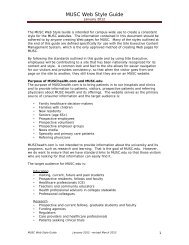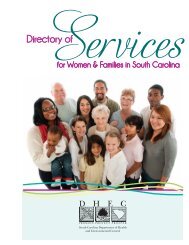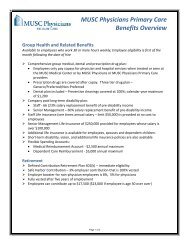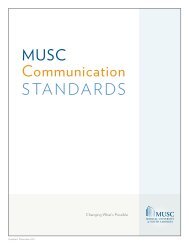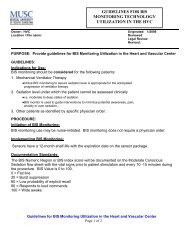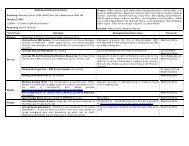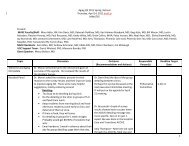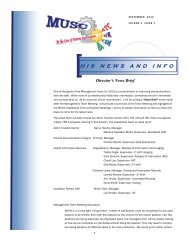"Medication Interventions for Fall Prevention in the Older Adult." J
"Medication Interventions for Fall Prevention in the Older Adult." J
"Medication Interventions for Fall Prevention in the Older Adult." J
Create successful ePaper yourself
Turn your PDF publications into a flip-book with our unique Google optimized e-Paper software.
<strong>Fall</strong> prevention <strong>in</strong> older adults ReviewsAssessment QuestionsInstructions: The assessment test <strong>for</strong> this activity must be taken onl<strong>in</strong>e; please see “CPE Process<strong>in</strong>g” below <strong>for</strong> fur<strong>the</strong>r <strong>in</strong>structions.There is only one correct answer to each question. This CPE will be available onl<strong>in</strong>e at www.pharmacist.com no later thanMay 31, 2009.1. <strong>Fall</strong>s are <strong>the</strong> lead<strong>in</strong>g cause of <strong>in</strong>jury-related deathsand <strong>the</strong> most common cause of nonfatal <strong>in</strong>juries andhospital trauma admissions among older adults.a. Trueb. False2. <strong>Fall</strong> risk may <strong>in</strong>volve which of <strong>the</strong> follow<strong>in</strong>g?a. Physical mobility issuesb. <strong>Medication</strong>sc. Home and environmental safetyd. All of <strong>the</strong> above alternatives are correct.3. A comprehensive fall-reduction strategy that addressesphysical mobility and ability to accomplishactivities of daily liv<strong>in</strong>g, medication management,home/room safety, and environmental (community)safety can be effective. However, failure of <strong>the</strong> strategyresults from which of <strong>the</strong> follow<strong>in</strong>g?a. S<strong>in</strong>gle causeb. Multiple causesc. Not consider<strong>in</strong>g drugsd. Alternatives b and c are correct.4. In addition to <strong>the</strong> four areas noted <strong>in</strong> question 3,most falls result from multiple risk factors thatshould also be taken <strong>in</strong>to account.a. Trueb. False5. Psychotropics are def<strong>in</strong>ed asa. Anxiolytics and hypnotics.b. Antipsychotics.c. Antidepressants.d. All of <strong>the</strong> above alternatives are correct.6. Psychoactives or central nervous system–activeagents are considered psychotropics anda. Metoclopramide and narcotic or opioid analgesics andantipark<strong>in</strong>son agents.b. Anticonvulsants and muscle relaxants.c. Antihistam<strong>in</strong>es and centrally act<strong>in</strong>g antihypertensives.d. All of <strong>the</strong> above alternatives are correct.7. Accord<strong>in</strong>g to <strong>the</strong> risk assessment <strong>for</strong> falls shown <strong>in</strong>Figure 1, what po<strong>in</strong>t total is considered high risk <strong>for</strong>falls?a. 2–5b. 5–7c. ≥8d. ≥108. Regular use of acetam<strong>in</strong>ophen 3.0 g/day <strong>in</strong> patientswith dementia has been shown toa. Decrease behavioral symptoms by 63%.b. Allow 75% of psychotropic medications to be taperedand stopped <strong>in</strong> patients with cognitive impairment.c. Alternatives a and b are correct.d. Have no effect.9. Giv<strong>in</strong>g hypnotics more often than how many timesper week has been shown to <strong>in</strong>crease fall risk?a. Once or twiceb. Two to three timesc. Three to five timesd. NightlyCPE Credit:To obta<strong>in</strong> 2.0 contact hour of cont<strong>in</strong>u<strong>in</strong>g pharmacy education credit (0.2 CEUs) <strong>for</strong> “<strong>Medication</strong> <strong>in</strong>terventions <strong>for</strong> fall prevention<strong>in</strong> <strong>the</strong> older adult,” go to www.pharmacist.com and take your test onl<strong>in</strong>e <strong>for</strong> <strong>in</strong>stant credit. CPE process<strong>in</strong>g is free<strong>for</strong> APhA members and $15 <strong>for</strong> nonmembers. A Statement of Credit will be awarded <strong>for</strong> a pass<strong>in</strong>g grade of 70% or better.You have two opportunities to successfully complete <strong>the</strong> posttest. Pharmacists who complete this exercise successfullybe<strong>for</strong>e May 1, 2012, can receive credit.The American Pharmacists Association is accredited by <strong>the</strong> Accreditation Council <strong>for</strong> Pharmacy Education as a provider ofcont<strong>in</strong>u<strong>in</strong>g pharmacy education. The ACPE Universal Activity Number assigned to <strong>the</strong> program by <strong>the</strong> accredited provider is202-000-09-122-H01-P.“<strong>Medication</strong> <strong>in</strong>terventions <strong>for</strong> fall prevention <strong>in</strong> <strong>the</strong> older adult” is a home-study cont<strong>in</strong>u<strong>in</strong>g education activity <strong>for</strong> pharmacistsdeveloped by <strong>the</strong> American Pharmacists Association.Journal of <strong>the</strong> American Pharmacists Association www.japha.org M a y /Ju n 2009 • 49:3 • JAPhA • e83





